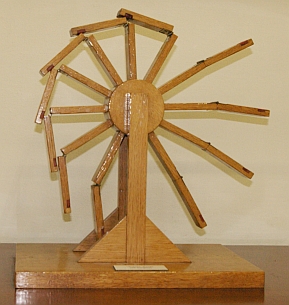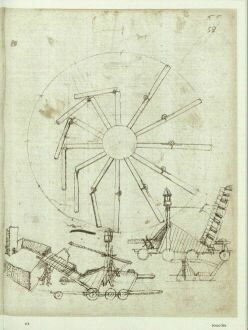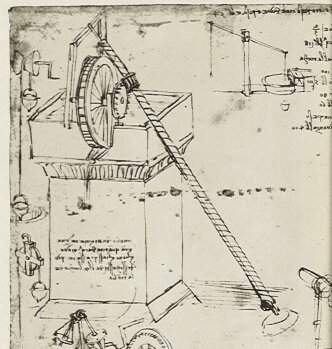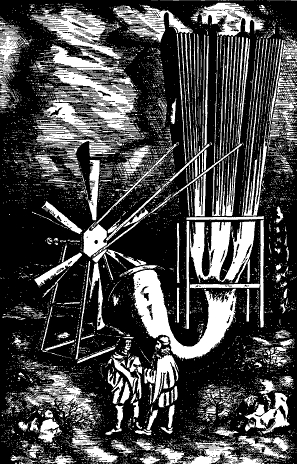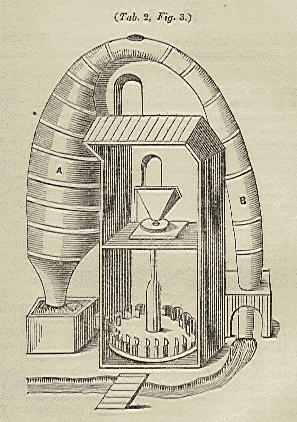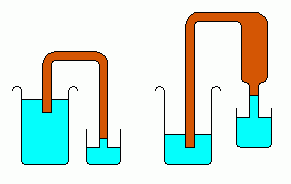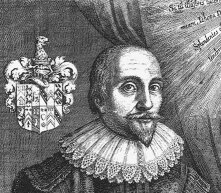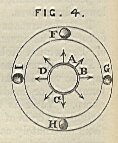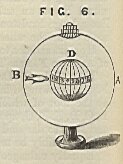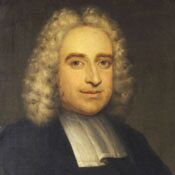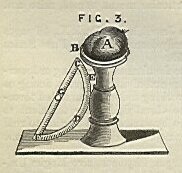A short history of the search for perpetual motion.
by Donald E. Simanek
Popular histories too often present perpetual motion machines as "freaks and curiosities" of engineering without telling us just how they were understood at the time. They also fail to inform us that even in the earliest history of science and engineering, many persons were able to see the futility and folly of attempts to achieve perpetual motion.
Sometimes a particular device comes to us with a label, such as "Bishop Wilkins' magnetic perpetual motion machine." Popular articles leave the impression that the inventor believed it was a perpetual motion machine. In fact, very often the device was presented and described to illustrate the futility of the quest for perpetual motion.
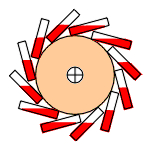 |
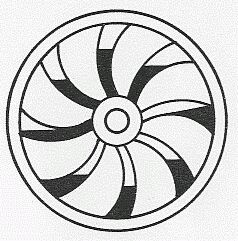 |
| Bhaskara Wheel. GIF by Hans-Peter Gramatke |
Bhaskara Wheel with curved spokes. |
|---|
Bhaskara's Wheels. The first documented perpetual motion machines were described by the Indian author Bhaskara (c. 1159). One was a wheel with containers of mercury around its rim. As the wheel turned, the mercury was supposed to move within the containers in such a way that the wheel would always be heavier on one side of the axle. Perhaps this was not so much a practical proposal as an illustration of Indian cyclical philosophy. The idea reappears in Arabic writings, one of which contained six perpetual motion devices. From the Islamic world the idea reached Europe.
|
Villard de Honnecourt was born in the late 12th century and probably lived and worked in the north of France from 1225 to 1250. His sketchbook of 33 parchment leaves with 250 drawings has survived, and now is in the Bibliothèque Nationale in Paris. These show designs for churches, catapults mechanisms and machines. Villard is often called an architect, but we know of no structure that he designed, or that is attributed to him. He traveled a lot, but we are not sure what he did for a living.
The most celebrated of his machine designs was for a perpetual motion wheel. It was an overbalanced wheel with hinged hammers or mallets equally spaced around its rim. The picture displays ambiguous perspective. The wheel is actually supposed to be perpendicular to the frame and to the horizontal axle. It also shows unequal spacing of the hammer pivots around the wheel. The two hammer pivots near the top are spaced closer together than the others. Perhaps it was intended to be "schematic only". Perhaps it was deliberate deception to make it seem overbalanced to the casual viewer. Compared to Villard's other drawings, this one is singularly "sketchy" and carelessly executed. Villard's description (translated) is:
Many a time have skilful workmen tried to contrive a wheel that should turn of itself; here is a way to make such a one, by means of an uneven number of mallets, or by quicksilver (mercury).
The reference to quicksilver (mercury) indicates that Villard was familiar with the Bhaskara device, whose design had reached Europe. Villard claimed his machine would be useful for sawing wood and raising weights.
Villard's diagram shows seven hammers, and he insisted on an odd (uneven) number of hammers, explaining
...there will always be four on the downward side of the wheel and only three on the upward side; thus the mallet or bag will always fall over to the left as it reaches the top, ad infinitum.But, whether the number of hammers is odd or even, such a wheel comes to rest quickly. This design was copied many times, often with an even number of hammers.
Mariano di Iacopo, called Taccola (Siena, 1382-1458?) was one of the first artist-engineers who wrote illustrated texts of engineering designs, using drawings effectively as a medium of communication. Living in a time of frequent wars, he was actively engaged in a diversity of military and civil engineering projects.
|
On this page of his drawings we see designs for machines to breach fortifications, and superimposed upon those is a large depiction of an overbalanced wheel with hinged articulated sections. This was a device probably well-known to engineers in this period of history, deriving from Arabian sources.
|
Leonardo da Vinci (1452-1519) was the prototype "Renaissance Man". His talents included art, engineering, music, physics, and mathematics. His famous Notebooks (a collection of drawings and commentary on loose manuscript pages) were largely unorganized "notes" to himself that he never put into a format for proper publication. These include ideas and designs from other sources, and some original ones, without indication of which were which. Leonardo was never shy about proclaiming his many talents, but he often started projects he never finished.
Leonardo's famous comment comparing perpetual motion seekers to alchemists is often quoted. "Oh, ye seekers after perpetual motion, how many vain chimeras have you pursued? Go and take your place with the alchemists." The last reference is to "seekers after gold", which at least one translator has misinterpreted as "gold-diggers".
Leonardo very carefully analyzed several versions of the overbalanced wheel with moving weights, and showed why they would not work.
Moreover, you might set yourself to prove that by equiping such a wheel with many balances, every part, however small, which turned over as the result of percussion would suddenly cause another balance to fall, and by this the wheel would stand in perpetual movement. But by this you would be deceiving yourself... As the attachment of the heavy body is farther from the center of the wheel, the revolving movement of the wheel round its pivot will become more difficult, although the motive power may not vary. [From Dircks (1861)]
This last comment is especially perceptive. In modern language it says that as a weight moves farther from the rotation axis, the gravitational torque on it is greater, but the moment of inertia of the wheel is simultaneously increased, making the gravitational torque less effective in increasing or sustaining motion of the wheel. The net gain is zero.
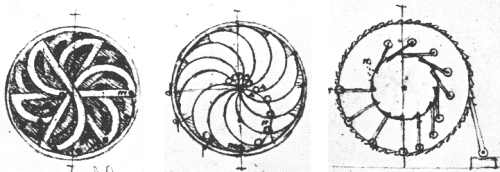 |
| Leonardo's drawings of perpetual motion wheels. |
|---|
|
The concepts of force, energy and momentum were not refined until the early 19th century. Leonardo's thinking about these matters was still largely Aristotelian, as these examples [translation by Edward MacCurdy] illustrate:
- Force is a spiritual capacity, an invisible power which is implanted by accidental violence in all bodies that are witheld from their natural inclination... [Force] always sets itself against natural desires.
- Weight is material and force is spiritual... They are often producers one of another.
- The sun has substance, shape, movement, radiance, heat and generative power; and these qualities all emanate from itself without diminution.
Aristotelian science held that things in the heavens were perfect and incorruptable. Therefore this last comment about the sun is consistent with Aristotelian thinking, and suggests that Leonardo had no conception of anything like a general principle of conservation of energy.
Many of Leonardo's drawings of machines were impractical or even unworkable as he depicts them. Most were never built or tested by him. Some were not his original ideas, but were commonly known in his time and earlier times. We often can't determine whether a particular device included in his notebooks was of his own design, or of someone else, and we can't always know whether Leonardo considered it workable or practical.
|
Mark Anthony Zimara (1460?-1523?), was an academic, natural philosopher, physician, astrologer and alchemist; interests typical of academics of his time. He published a scholarly work on physics and metaphysics in 1518, in which he describes (without pictures) Directions for Constructing a Perpetual Motion Machine without the use of Water or a Weight.
Construct a raised wheel of four or more sides, like the wheel of a windmill, and opposite to it two or more powerful bellows, so arranged that their wind will turn the wheel swiftly. Connect to the periphery of the wheel, or to its center (whichever the builder may think better), an instrument which will operate the bellows as the wheel itself turns (this will be an honor to the ingenuity of the maker). It will happen that the wind which comes from the wheel to rotate, and that the bellows themselves, operated by the rotating wheel, will blow perpetually. This, perchance, is not absurd, but is the starting point for investigating and discovering that sublime thing, perpetual motion, a starting point which I have not read of anywhere, neither do I know of any one who has worked it out. [Tr. by G. Kasten Tallmadge.]This is an early example of the "boostrap" principle of perpetual motion. [The combination of Archimedian screw and water-wheel was an earlier example.] Device A drives device B which in turn drives A. But it was not the last application of the principle, though it should have been. Note that Zimara claims this to be his original idea. Zimara leaves to others the tricky problem of designing the mechanical linkage between bellows and windmill, and he admits that he knows no one who has made such a thing work. Of that we can be certain.
Zimara's description contained no drawing. The drawing here is an artist's fanciful interpretation, with some geometric engineering flaws that, even if corrected, would not allow the device to work.
 |
Agostino Ramelli (1531-ca. 1600) published in 1588 a large foilo collection Treasury of the ingenious machines of the noble and famous Captain Agostino Ramelli with text in both Italian and French. It contained 195 detailed plates with accompanying commentary. One, plate 43, attracts our attention. At first look just a floating water wheel for lifting water from a river (a common device of the time), more careful examination shows that it has within the waterwheel two perpetual motion devices, the wheel of Honnecort, and the curved-compartment wheel, both being ideas from the Orient via Arabia. Ramelli explains:
You should know that the interior of this wheel was made to please a gentleman who requested me to do it because he thought that since the current of the river was too slow it should be aided by a wheel. Thus anyone can make use of it if he judges it suitable.
 |
So, if you need more power, just add a perpetual-motion wheel, or better yet, add two of them! Ramelli's last sentence must be interpreted as tongue-in-check, indicating that he doesn't think the extra wheels really help, but as he was building this for a client, who was paying for it, the customer gets what he wants. We know nothing about Ramelli's personality, or whether he had a sense of humor, but I can't help thinking this drawing was his little joke.
Closer examination of the original engraving shows the innermost part of the wheel has curved-wall compartments, with something (water, pebbles, lead shot?) in each compartment. Such wheels were then common (though inefficient) devices for lifting water, driven by the current of the river. It was called the Persian Wheel, the horn-drum, or De La Faye's wheel. The same design shows up in stand-alone self-motive wheel designs. But in this picture, the inner part of the wheel is clearly not being driven by water in the river.
 |
 |
| Two versions of the Persian water wheel. |
Bhaskara perpetual motion wheel. |
|---|
|
Vittorio Zonca (1568-1602). In his folio "Novo Teatro di Machine et Edificii", (Padua, 1607) Zonca shows a large copperplate engraving of a huge pipe for raising water. It had a large, sealed inverted U-tube with larger diameter on one side. The figure shows the larger tube (A) on the left emptying water at a higher level than the water intake on the right. This water then powered a horizontal turbine at the bottom, which drives a millwheel for grinding grain. The sealed port at the top was to facilitate the initial filling of the tube with water.
For want of a better name, I call this a "perverted siphon", though it doesn't work as a siphon. (It's so hard to name devices that don't work.) Didn't folks in the 17th century know that siphons can only lift water over an elevation if the output tube's opening is lower than the input water level? Perhaps not. Roman engineers had successfully used water tubes or pipes to transport water over hills, but the output was always lower than the input water level. These tubes were a last resort for engineers, for the apex of the tube could not be higher than 10 meters above the water level at the input end. It was difficult to seal the tubes so that air would not seep into the top of the tube and eventually form an air pocket that destroyed the continuity of the water and halted water flow. Perhaps some felt that it was only such practical "engineering difficulties" that prevented the use of siphons to actually deliver water to a higher level.
Remember that the role of atmospheric pressure in these devices wasn't understood. So why did the water stay in the inverted U-tube? This was explained by Aristotle's principle that "nature abhors a vacuum", that is, nature will not allow a vacuum in the top of the tube and will do whatever necessary to prevent it. This explained why a suction pump could lift a column of water (but didn't explain why it could only lift water about 33 feet).
|
What, then, was the prevailing understanding of the siphon, which led to the supposition that it could work "in reverse", rasing water from a lower to a higher level? First, why does the normal siphon permit water flow from the higher end to the lower end? In the case of the uniform diameter tube with one end lower than the other, the low end has a longer length, measured from the top, and therefore contains a greater weight of water than does the shorter tube. A beam balance, moves downoward on its heavier side. By analogy, one might assume that water moves toward the lower end of the siphon because that side is heavier. This would be consistent with the prevailing view that when something is heavier on one side, this causes motion toward the heavier side. In fact, this is a central idea behind many perpetual motion machine proposals.
So it is only a short logical step for a clever engineer to suppose that you could make the shorter side contain more water than the long side simply by making the shorter side larger in diameter. It would contain greater weight of water, so water should flow toward that side, even if that side were emptying at a higher elevation. The water, however, refuses to oblige.
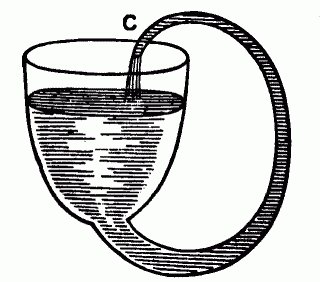
|
This same flawed explanation is displayed by the self-flowing flask (later known as the hydrostatic paradox). The larger weight on the left forces water down and around the narrow neck where the weight is less, and then it flows out the orifice at the top to replenish the water in the vase. The "paradox" was, that though this seemed perfectly reasonable to many persons, the darn thing just didn't work that way. In fact, it worked in accordance with another Aristotelian principle "water seeks its own level". The water levels were equal left and right, and stayed that way.
These problems were much discussed in Medieval and Renaissance times, when Aristotelian physics still dominanted thought, but scholars were beginning to question, and even modify, some Aristotelean notions. Unfortunately much of this was done by Aristotelian methods: the use of pure analytic logic without recourse to experimentation. So practical engineers were left to wonder how things really worked, and often operated with inadequate or incorrect conceptual tools.
Here's where engineers ought to have paid more attention to the ancient sources. Aristotle stated that "water seeks its own level" and Heron of Alexandria had described the correct operation of the siphon with the outlet lower than the inlet and the diameter of the pipes having no influence on the operation. Cf. Heron's "Pneumatica".
Even Galileo accepted the "abhorrence of a vacuum" principle. In 1643 Evangelista Toricelli (1608-1647) showed experimentally that the pressure of the atmosphere could lift a column of mercury only about 30 inches, and if mercury were used to fill a four-foot long tube, and the tube inverted with the open end in a mercury reservoir, the mercury column would be only about 30 inches above the reservoir level, with a "Toricellian vacuum" above it. A column of water could only be lifted about 33 feet in the same manner.
Only in the late 17th century were these misunderstandings of water pressure resolved. Pascal's principle showed that the pressure at any point in a container of liquid depends only on height from that point to the surface, and not on the diameter or shape of the container.
|
Robert Fludd (1574-1637), a Paracelsian physician, alchemist, astrologer, hermetic philosopher, mystic and member of the Brotherhood of the Rosy Cross, published a folio of his works in 1618 (in Latin). It included many descriptions of machines, some practical, some fanciful. These included water pumps of various kinds.
The picture below left is often attributed to Fludd, and many books leave the impression that Fludd believed it would work. But its style is not consistent with other pictures of Fludd's time. In "De Simila Naturae" Fludd does discuss the machine shown below right, which he describes:
Of another useful invention for raising water easily, by which a certain Italian ventured to boast that he had discovered a perpetual motion.
 |
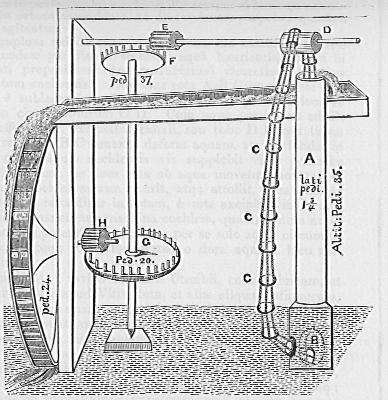 |
| Recurculation mill. This proposed to use perpetual motion to generate useful work (driving a millstone). |
An Italian's recirculation mill. Fludd De Simia Nature 1624. |
|---|
The column at the right is a pump with a chain of leather disks (A). The water lifted by the pump drives the overshot water wheel, which, through several gears, drives the pump. Fludd is forthright in his opinion of the utility of this device.
The Italian, deceived by his own thoughts, conceived that as much water would be raised by this pump as would keep the wheel perpetually in motion; because he said that more force was required at the extremity of this machine than at the center; but because he calculated the proportions of power wrong, he was deceived in practice.Fludd has no hope that any such machine could achieve perpetual motion.
It is unnecessary to point out that this appealing principle has been tried several times, by people who often were completely inexperienced in mechanical principles, and who did not see the serious error which lies in these devices, and therefore wasted effort, money and time on old and worthless ideas.The illustration at the left, from the 1600s, shows a perpetual motion scheme used for generating useful work without any input work. Most earlier devices before the 16th century did not claim work output. Zonca's recirculation mill and Ramelli's water wheel were also intended to produce useful work, or to increase the work done by natural sources (like flowing water).
|
Athanasius Kircher (1601-1680), a German Jesuit who taught in Rome. His many interests were wide-ranging, and included mathematics, geography, astronomy, optics, and magnetism (de Arts Magnet). He designed and built automatic mechanical music instruments programmed by a pegged rotating drum, and wrote music for them. He also designed a machine to compose music. He was reputed to be somewhat of a showman and a prankster.
Kircher's folio includes a water wheel driving a force pump to lift water to the top of the wheel, and designs for magnetic spheres and wheels turning continually in response to fixed magnets.
| ||||
One plate shows the water cycle, according to one popular theory. Water is sucked down whirlpools in lakes, passes through fissures in rock and by capillary action rises to the topes of mountains where it gushes forth in springs. These springs are the source of mountain streams, which in turn feed the lakes. At this period of history many could not accept that all water in streams and rivers could have its origin from rainfall. Also, many still felt that water had some innate capacity to rise against gravity. Perhaps they should have gone back to Aristotle, who knew that "Water seeks its own level."
 |
| Kircher's water cycle. |
|---|
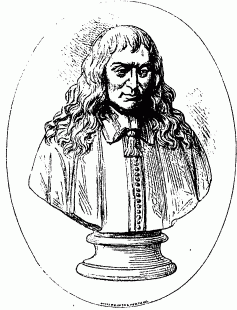 |
Edward Somerset, Sixth Earl and Second Marquis of Worcester (1601-1667) published in 1663 Century of Names and Scantlings of Such Inventions as at Present I Can Call to Mind Have Tried and Perfected usually refered to as A Century of Inventions. Somerset was a prominent public figure who was interested in science, mechanics and mathematics and made useful suggestions and improvements for them, especially for the use of steam as a motive power. He has some claim to being the inventor of the steam engine. The PDF of his book is free online, and certainly worth no more.
In the 56th article of his book, he describes an overbalanced wheel in some detail. The original book edition of A Century of Inventions gives no image of the described machine. [The image which is frequently published as Somerset's overbalanced wheel was published later, by Desaguliers, and dates from 1720]. The sketch reveals nothing, for it shows no more than a large enclosed wheel with a relatively small axle, to which a rope is wrapped in order to lift weights and perform other mechanical work. Here's Somerset's description, which makes no such claims:
56. To provide and make that all the weights of the descending side of a wheel, shall be perpetually farther from the center, than those of the mounting side, and yet equal in number and heft to one side as the other. A most incredible thing, if not seen; but tried before the late King (of blessed memory) in the Tower by my directions, two extraordinary ambassadors accompanying his Majesty, and the Duke of Richmond, and Duke of Hamilton, with most of the Court attending him. The wheel was fourteen feet over, and had forty weights of fifty pounds apiece. Sir William Balfore, then Lieutenant of the Tower, can justify it, with several others. They all saw, that no sooner these great weights passed the diameter line of the lower side, but they hung a foot farther from the center; nor no sooner passed the diameter line of the upper side, but they hung a foot nearer. Be pleased to judge of the consequence.That's it. That's all he said. There's no claim that the wheel turned by itself, only that it was always heavier on one side. But many who write about perpetual motion assume that it did turn due to its overbalance. Seekers of perpetual motion are chasing down a dead end road here.
It's too bad we don't have an account of the King's reaction to this lame demonstration. The enigmatic "An incredible thing, if not seen..." is frequently quoted, as if it were somehow profound.
 |
Johann Ernst Elias Bessler (Councillor) Orffyreus (1680-1745), a German Pole, had been Councillor to the Prince of Hessen-Kassel (Germany). He studied theology and medicine, but his interests focused on mechanics, particularly clockmaking. He claimed to have experimented with 300 different perpetual motion machines, finally making two working perpetual motion machines between 1712 and 1719. When the government of Hessen-Kassel imposed a tax on the money he collected from those who came to see his wheel (which he gave to charity), he destroyed (dismantled) the wheel in a fit of anger. Bessler had an erratic temperament, alternating between melancholy and great anger.
Bessler published, in 1717, a pamphlet (in German and Latin) titled Perpetuum Mobile Triumphans by Orffyreus. In it he complains about his critics and opponents: those in the scientific world, persons in high authority, the public in general, and the press. At this time he enjoyed the favor of the Prince of Hessen-Kassel, who provided him lodging and other support. Bessler claimed he had succeeded in making "a dead material not only move itself, but lift weights and perform work", and he declared that "even the most profound mathematicians and the most learned people have continually fallen into error" in their appraisals of his invention. There's some truth in that.
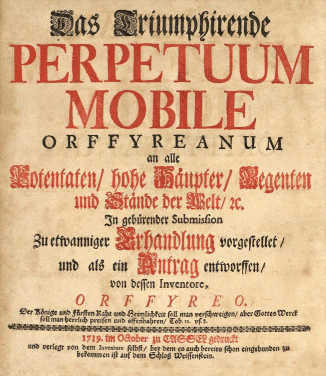 |
Of the 300 machines Bessler said he constructed, four were publicly demonstrated and observers gave detailed accounts of them. Some values in the following table should be treated as approximate, for different accounts give slightly differing numbers. Some accounts give the dimensions in Flemish ells (27 in), some in Leipzeg ells (22.3 in), some in Rhenish feet (31.4 cm) and some in inches and feet, and who knows what some of the translators did when converting measurements. The ell was a unit usually used for measuring cloth, and there were also English els and Scottish ells, all different. We need not fuss about these matters here, for the only purpose of this table is to give a general impression of the size of the machines.
| Date | Place | Diameter | Thickness | Axle diam | Axle length | Bearing diameter | Lifted weight | Speed (no load) | Speed (load) |
|---|---|---|---|---|---|---|---|---|---|
| 1712 | Gera, Reuss | 3 ft | 4 in | several lbs | 50 rpm | ||||
| 1713 | Drashwitz | 5 ft | 6 in | 40 lb | 50 rpm | ||||
| 1715 | Mekelberg | 6 ft | 12 in | 6 in? | 70 lb | ||||
| 1717 | Kassel Weissenstein |
12 ft | 14 - 18 in | 8 in | 6 ft | 3/4 in 1 in? |
70 lb | 26 rpm | 20 rpm |
In 1717 Bessler built his largest wheel, which the Landgrave of Hessen permitted to be constructed and set running in a closed and locked room, secured with the Landgrave's seal on Nov 12, 1717. On Nov 26, the room was opened and the wheel found still running. The room was closed again, and not reopened until Jan 4, 1718, when the wheel was found to be still running, apparently at the same speed it had when started in November. Many came to observe this machine with admiration and wonder. Bessler describes this wheel as follows:
| Bessler said he invented the name "Orffyreus" by evenly spacing the letters of the alphabet around a wheel, then translating the letters of "Bessler" directly across the diameter of the wheel to get "Orffyre", then latinizing it. If this was his method it may be symbolic of the supposed principle of his perpetual motion wheel, shifting weights across the wheel axis. |
I put all in fresh order, and began work in all possible haste, doing everything in the manner of those I had already made and destroyed, with only a few changes in the dimensions of the so-named turning-wheel. For as a grindstone may be called a wheel, so may the principal part of my machine be named. The outward part of this wheel is drawn over or covered with waxed linen in the form of a drum. This cylindrical basis was 12 Rhenish feet in diameter, the thickness from 15 to 18 inches, the middle axle 6 feet long and 8 inches in thickness. It is supported in its movement on two pointed steel balance-pegs, each 1 inch thick; and the wheel is vertically suspended. The movement is modified by two pendulums, as shown in the engraving at the end of this book. The inward structure of the wheel is of a nature according to the laws of mechanical perpetual motion, so arranged that by disposed weights once in rotation they gain force from their own swinging, and must continue their movement as long as their structure does not lose its position and arrangement. Unlike all other automata, such as clocks or springs or other hanging weights which require winding up or whose duration depends on the chain which attaches them, on the contrary, these weights are the essential parts and constitute perpetuum mobile itself; as from them is retreived the universal movement which they must exercise so long as they remain out of the center of gravity; and when they come to be placed together, and so arranged one against another that they can never obtain equilibrium, or the punctum quietus which they unceasingly seek in their wonderous speedy flight, one or other of them must apply its weight vertically to the axis, which in its turn will also move.
In this passage Bessler tells us that:
- This wheel was not self-starting; it needed a push to get it moving. It could operate turning in either direction. His previous wheels were self-starting, but only turned in one direction.
- Bessler claimed it did not derive its power from wound springs or falling weights, as was common with automata and clockwork devices. It had many moving weights inside, arranged with the purpose of keeping the wheel continually unbalanced.
Bessler had a reputation as a very skilled clockmaker, and such a large wheel can sustain flywheel motion for a very long time. Clocks could be made to run a year without winding. Some speculated that the wheel had many compartments around its perimeter, each with a shifting weight inside. Some even thought there might be an animal or small person inside, but I think that speculation can be dismissed.
Apparently only one other person had the privilege of seeing part of the interior of the wheel, Bessler's patron, Karl, the Landgrave of Hesse-Kassel, and he was sworn to secrecy. But did he see everything inside, or only what Bessler wanted him to see? It is not at all clear whether Karl saw all compartments open at the same time. Did he look at what might be hidden behind the obvious mechanical details, into the back panel of the wheel itself, or inside the six-inch diameter axle? Consider magicians' stage illusions in which people and even animals can be hidden by clever design of a cabinet or other stage apparatus, and by the simple strategy of opening different parts of a box at different times.
Bessler's wheels were connected to two pendulums, driven by the wheel's axle, and we can probably accept his statement that they regulated the wheel's speed. Some drawings show a rope wrapped around the larger axle, passing to a pulley at the floor, and then up to a pulley near the roof, to which a load was attched. One wonders why the extra pulley was necessary, and why this rope passes through a hole in one of the upright wheel supports. This hole would surely weaken that support, and seems unnecessary. Clearly some details are not to scale in these drawings, though the overall scale is indicated by a rule along the bottom edge of the drawing. (The units are Leipzig ells.) This illustration above shows a stamping mill being driven on the left by pegs in the axle. It also shows a brake near the bottom edge of the wheel. Some illustations show a rope belt driving an archimedean screw for lifting water.
Most accounts say the load was a "70 pound box of bricks". This same figure is given for demonstrations of all of the various sized wheels. Yet no account casts suspicion on this, and none tell of any independent measurements of its actual weight. (I've seen one source that says one of Bessler's wheels, turning at 50 rev/min lifted 16kg (35.274 lb) a distance of 1.5 m (4.9 feet)—somewhat more believable values.) None mention anyone actually examining the bricks in the box to ensure that they were solid. This is just one of many details that seem a bit "fishy" and lead us to conclude that the existing accounts of the public demonstrations are sadly deficient in important information, and not as impressive as they might seem on first reading. Some who told this story may have been copying others, and also exaggerating.Some of the later wheels could turn in either direction, and they both lifted and lowered this box of bricks while it was connected to the wheel. Whatever the box weighed, the energy required to lift it was largely given back upon lowering it, so repeated raising and lowering is not particularly impressive.
|
The Landgrave hired natural philosopher and engineer Professor 's Gravensande of Leyden (1688-1742) to investigate the machine. He observed it (without being allowed to look inside) and described it in a letter to Sir Isaac Newton.
"... hollow wheel, a kind of drum, covered over with canvas to prevent the inside from being seen. I have examined the axles and am firmly persuaded that nothing from without the wheel in the least contributes to its motion".We have no record that Newton ever replied. Newton disliked being a part of any controversy.
The Professor observed (as had others) that when the wheel was stopped and then released, it would gradually resume its motion at the original speed within a few revolutions. His letter seems to support the claims that the machine was self-moving.
On hearing that 's Gravensande had examined the machine without his consent, Bessler again destroyed the machine, leaving a message on the wall saying that he had been forced to do this by the impertinance of 's Gravensande. He shouldn't have been so hasty, for 's Gravensande had only looked carefully at the wheel's exterior and its bearing supports, and found nothing suspicious there.
Naturally, Bessler was suspected of fraud in this matter. Unsubstantiated stories circulated that a servant had signed an oath that in an adjoining room she had turned crank to keep the wheel in motion. This raises the obvious question of why s' Gravensande had not checked the adjoining room, for it might have had more than just a hand crank—mechanisms that might not have been noticed or understood by a housemaid but might have meant a lot to 's Gravensande, had he seen them. Such allegations caused Bessler to construct his most impressive machine in the center of a room, well removed from walls, to allay any suspicions. It's difficult, if not impossible, to judge the credibility of the details of such charges this long after the fact. It is equally impossible to judge the accuracy and credibility of observers who enthusiastically accepted the demonstrations as proof of perpetual motion. There's no good reason to doubt that deception was involved in all Bessler's demonstrations, but exactly how it was accomplished in each case can be no more than speculation. Remember also that these devices were made in at least four different sizes and were demonstrated in different places and under different circumstances. While many external construction features are alike in these, we have no assurance that their interior mechanisms were the same in all cases. Deception may well have taken different forms as circumstances changed.
It's not difficult to postulate many ways that the public demonstrations of the wheels could have been accomplished, for they were of short duration (typically no more than a half hour) and did not require large energy output. In these cases the wheel was observed in motion throughout a brief demonstration, then it was braked to a stop. It was then restarted for another demonstration, and sometimes the wheel was lifted off its supports and replaced, or placed on another set of supports. Once a cylindrical lead weight was removed for examination from within the wheel and then replaced by Bessler. Accounts say it was estimated to weigh 4 pounds, but do not say whether anyone but Bessler handled it, nor do they say that anyone independently weighed it.
The most widely documented and discussed demonstration was that in which the running wheel was placed in a castle room, the room completely sealed, guarded, and opened after 10 days, to find the wheel still running. The room was closed again, and opened after 43 days, when the wheel was again found running. Most people supposed it had been running continually for 53 days—nearly two months. During this time all doors and windows to the room where closed and sealed. The stone walls were a foot thick. No one had any way to verify that the wheel was actually turning during the entire time. The wheel might easily have been caused to stop after the room was sealed, and started again just before the room was opened. Also, there's no assurance that this wheel was of the same internal construction as the wheels that had been used in other, more public, demonstrations. Rather than being a convincing experiment, this raises suspicion that Bessler was engaging in deception of the kind used by stage magicians. The magic occurs out of sight, to hide the secret. And there's no rational reason for anything to happen out of sight in this case.
- The sealing of the room must have been complete, so that no one could see
inside to verify that the wheel was running. Otherwise there'd be no need
to open the room after 10 days to confirm that it was still running.
Why wasn't a small window left open to admit light, so that anyone
at any time could look inside and confirm that it was running? After all, guards were
posted at the door, so this would not have compromised security. We have very good
reasons to be suspicious that during the closed intervals, the wheel was not turning.
- There's no mention that this wheel performed any work before, during or after this demonstration. The mechanism in the wheel may have been very different from that of the wheels used in the working demonstrations. I find it curious that most writers on this subject simply assume that this wheel was exactly like the others, when that has no support in the historical records.
- During demonstrations of all of Bessler's previous wheels
observers remarked that the wheels were noisy.
The clatter of the weights inside the wheel was clearly heard, and some reported hearing
"scratching noises" (like those of a tightly coiled spring?).
Could these noises not be heard even outside the sealed room?
If these sounds were heard during the entire 53
days surely someone would have cited this as strong evidence in favor of Bessler.
If the sounds stopped after the room was sealed, surely someone would have
cited this as evidence of fraud. But no one even mentions any sound.
Why was the room sealed so tightly that no sound at all could be heard through one of the sealed doors? Allowing some sound to be heard the entire 53 days would have been a simple way for Bessler to make the demonstration more convincing.
| Thus it is a mechanical plaything and an illusion, and if in the future someone wants to take the trouble of writing about mechanical charlatans, this wheel deserves the highest and most distinguished position among them. —Christian Wagner, Mathematician (1715) |
What is really amazing is how many people today still think Bessler's machines may actually have been honest and that they were genuine perpetual motion. Many words have been devoted to Bessler apologetics, often exhibiting ingenuity at rationalization every bit as inventive as Bessler himself.
While Bessler's public activities get the most attention, and the evidence of fraud is compelling, he may at the same time have been engaged in a sincere quest for perpetual motion. He was working on a book with 140 illustrations, an astounding collection of perpetual motion designs of his day and earlier times. There we find the overbalanced wheels of the orient, and even some simple folk toys. He called it his "great treatise on mechanics". Bill McMurtry has these designs on his website Maschinen Tractate, and he plans to redraw all of them (the originals are often in very poor condition), with translations of the accompanying text, to be made available as a book. So comprehensive is this collection that I frequently get drawings from people who suppose they have invented a new perpetual motion machine, which turn out to be minor variations of one Bessler included in this collection.
Bill McMurtry has collected information and pictures about the Bessler affair at his Orffyreus returns website. John Collins has a wealth of materials at Johann Bessler's Gravity Wheel.
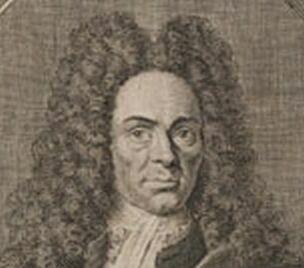 |
Jacob Leupold (1674 –1727)
Jacob Leupold's interests and talents focused on "mechanical things". He was a maker of instruments for experimental physics, a scientist, mathematician, educator and economist. His very popular and influential book, Theatrum Machinarum Generale (The General Theory of Mechanics, Leipsic, 1724) was a collection of mechanisms and machines of many kinds, and has been called the first systematic analysis of mechanical engineering. It included a design for a high pressure noncondensing steam engine, much like those built nearly a century later. As with most book collections of mechanisms, he analyzed a common perpetual motion wheel, unfortunately known today as "Leupold's wheel" though Leupold didn't invent it, and he very clearly declared that it couldn't work, based on his careful analysis.
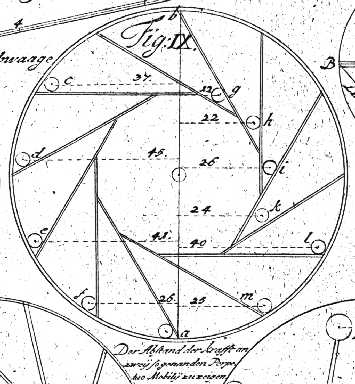 |
| Leupold's wheel. |
|---|
Excerpt from: Theatrum Machinarum Generale, Leipsic, 1724. p. 31-33.
The Perpetuum Mobile, or the machine that runs without external power without stopping, as long as material lasts and nothing breaks, moving itself, is so well known by name today that even the minor craftsmen, even bootmakers and tailors, not only talk about it, but fancy they could make such a thing if they only had money and time. As this is something that many have searched for with great desire, time effort and cost, then surely it is perpetuum mobile.The last paragraph suggests that Leupold realized that "you can't get more work out than you put in". Though he uses "pound" as a measure of work, we do not doubt that he was well aware of Archimedes' law of the lever, in which two different weights with different lever arms can be in equilibrium.And this desire is, even today, so deeply anchored in so many that they would rather let themselves be beaten to death than confess that they failed.
The reason is that these people have no foundation in mechanics. Many do not know how to calculate motions, and therefore, because of that, start construction based on imagination and haphazard experimentation. And so, to all who persistently search for perpetual motion, you should tell them:
1. They should design it with the simplest components, as the more pinions, cogs and materials it contains, the less chance of success. And if success is not achieved with simplicity, it will not be achieved with composite machines.Although, among many hundreds or even thousands of seekers, not one has ever found perpetuum mobile, not all of that effort was in vain, because many of them found their way to mechanics who otherwise didn't have that in mind. All they have learned is that man cannot achieve more in mechanics than God allows, and that with one pound nothing more than one pound can be moved, but only kept in equilibrium. But if there should be more, then more space and time must be available, and because of that, all those who want to achieve more, as being possible with machines according to the principles of mechanics, should be characterized as examples of Dr. Becher's "wise fools".Additionally, 2. No one shall begin the work unless he has analyzed the machine on paper: friction, rest, centrifugal effects of the parts moving in circles toward the periphery, the distances; everything being well measured and calculated.
And, 3. Those who cannot do these calculations and do not understand the principles should refrain and leave the task to others. They will not only lose time and money, but what is worse, will never find satisfaction. I could cite many examples.
Leupold's comment about the necessity of "more space and time" for achieving more than the laws of mechanics allow, suggests that he realizes that machines are limited by geometry, and that only by assuming a different geometry can one imagine circumventing those laws. But perhaps we read too much into a cryptic comment.
Leupold was not claiming to have disproven the possibility of perpetual motion. Indeed, he had heard second hand accounts of Bessler's demonstrations, and seemed to accept them.
Notwithstanding we hold that perpetual motion is not an impossibility, as been shown to all the world by Councillor Orffyreus, and attested by the princely word of the Landgrave of Hesse Cassel, a prince himself well grounded in the science of mechanics, and who so minutely scrutinised and observed this wonderful motion, which was with him on trial during two months; all of which time he kept the machine in a sealed chamber." [Dircks, vol 1, p. 22]
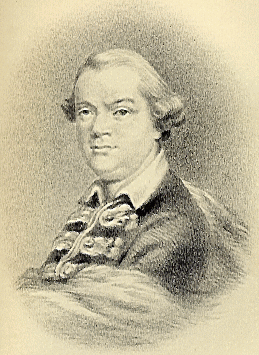 |
Dr. William Kenrick (1725?-1779), a writer and satirist, published in 1770 "A Lecture on the Perpetual Motion," in which he describes the inventions of the Marquis of Worcester and Councillor Oryffyreus, and other perpetual motion ideas. Kenrick had been pursuing this chimera for quite a while.
One species of our predecessor's merit, however, I presume myself at least entitled to, that of perserverance; it being now fifteen years since I first engaged in this underatking, which I have since pursued with almost unremitted assiduity, and that not only at considerable waste of time and expense, but under the constant mortification of hearing it equally ridiculed by those who do know, and by those who do not know, anything of the matter.
Kenrick is annoyed with mathematicians who claim to have proven the impossibility of perpetual motion, yet Kenrick asserts that "No such demonstration was ever published by any." He describes the demonstrations of the Marquis of Worcester, noting:
...though the wheel was polite enough to turn about while his Majesty was present, it could not be prevailed upon to be so complaisant in his absence. The mathematicians avenged themselves of the short triumph of the mistaken Marquis, but were equally mistaken themselves in thinking they had routed the problem or that in hunting down the jackal they had destroyed the lion. The perpetual motion survived; it has still its advocates; Professor 's Gravensande and John Bernoulli maintained its practicability, the former giving his testimony in favor of Orffyreus' machine, after a long and scrutinous examination.
Bishop John Wilkins (1614-72) is probably best known as a founder and first secretary to the British Royal Society (founded in 1660 and received the Royal Charter in 1662). He compiled a book Mathematical Magick during a period in history when the "magical arts" were being overtaken by "scientific and mechanical arts", and people began to realize that many things once thought magical could be understood by science.
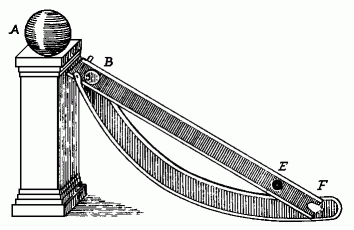 |
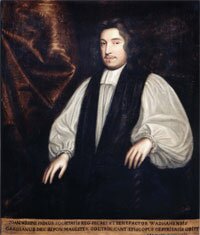 |
| Wilkins' Magnetic Perpetual Motion. Dircks (1861). |
Bishop John Wilkins. |
|---|
Earlier, in the year 1600, William Gilbert's book de Magnete appeared. Readers were fascinated with Gilbert's accounts of his experiments with magnetic lodestones, and these revelations of a new science of magnetisim fueled their imaginations. Some misunderstood and misapplied this new science. Johannes Kepler tried (and discarded) many ideas to explain the motion of planets. One of these was the hypothesis that the sun was a huge magnet whose field somehow kept the planets in motion. Anton Mesmer thought that magnets could influence the human body, and that they could transfer their "magnetic influence" to a person, who could in turn transmit it to others. Thus was born the notion of "animal magnetism" and "mesmerism".
|
Wilkins discusses the 'difficulty' of achieving perpetual motion, and considers in detail a device attributed by Schott (in his 1659 Thaumaturgus Physicus, sive Magiae Universalis Naturae et Artis) to Johannes Taisnierus [Dircks, 1870, p. 93]. It consists of two tilted ramps, an iron ball, and a magnetic lodestone fastened at the top. [This was a "clad" lodestone, a natural chunk of magnetic ore encased in an iron ball, such as were used in Gilbert's experiments.] The lodestone at the top (A) pulled the ball (F) up the straight ramp, where it fell through the hole (B) to the lower ramp, rolled down, and through another hole (F) to the straight ramp where it was pulled up again. Clearly this idea needs a lot more thought and work. Why doesn't the ball simply remain at the top, held strongly against the fixed magnet? And if it did fall through the top hole it would still be under the attractive influence of the magnet at the top. It's hard to imagine anyone who ever worked with magnets taking this seriously, but many later inventors did, trying futile variations. Even today, perpetual motion enthusiasts experiment with fantastic variations of "magnet motors" hoping that new magnet technology and stronger magnets will make them "go".
After a detailed discussion of practical difficulties, Wilkins finally gets to the bottom line, noting that "the bullet would not fall down through the hole, but ascend to the stone." But he still has some hope that such a device might be made to work:
So that none of all these magnetical experiments which have been as yet discovered, are sufficient for the effecting of a perpetual motion, though these kind of qualities seem most conducible unto it; and perhaps, hereafter, it may be contrived from them.
Sir William Congreve (1772-1829) was a politician and inventor. His inventions included a widely used military rocket, a color printing process and a new steam engine design. In 1827, while convalescing from an illness, he devised a variant of the classic inclined plane and chain perpetual motion idea, which Simon Stevin had shown to be useless. Congreve used an inclined plane, three guide rollers and a chain of sponges! The sponges at the left hand side were heavy because they were soaked with water by capillary effects thus causing an unbalanced force downwards. They were pulled through the reservoir and then up the incline. As they were pulled up the incline, weights moving along above them squeezed out the water, making the sponges lighter.
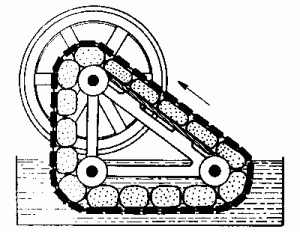 |
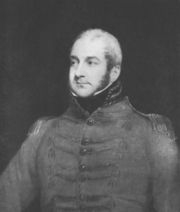 |
| Congreve's sponge belt perpetual motion device. |
Sir William Congreve (1772-1829) |
|---|
A description of this appeared in the Atlas (London) and this account was reprinted in The Mechanic's Magazine (London), both in 1827. We can only speculate whether some tried to build this, and were disappointed, or whether no one capable of building it had the slightest confidence it could work, so didn't try. Later Sir William published, at his own expense, a pamphlet explaining and defending his own confidence in this idea. Yet there's no evidence he ever built one to test. One wonders why, for he surely could have afforded materials and could have hired experienced mechanics to build such a relatively simple machine.
References and additional reading:
When I first became interested in this subject, most of these references were rare, hard to find books. I was fortunate to have copies of them. Now [2012] many of them are available as free ebooks. Others are available in expensive reprint editions. There's now no excuse for any hopeful perpetual motion machine inventor to be ignorant of the long history of this subject.
-
Angrist, Stanley W. "Perpetual Motion Machines" in Scientific American,
Jan 1968. This article is also in a Sci. Amer. reprint book.
-
Angrist, Stanley W. and Loren G. Hepler. Order and Chaos. Basic Books,
1967. [QC311.A5]
-
Collins, John. Perpetual Motion: An Ancient Mystery Solved?
Permo Publications, 1997, 2005.
A history of Johann Bessler, compiled from original sources.
-
Dircks, Henry. (1806-1873) Perpetuum Mobile, or the search for self-motive
power during the 17th 18th and 19th centuries. London, E. & F. Spon,
16 Bucklersbury, 1861. Rogers and Hall Co., 1916.
-
Dircks, Henry. (1806-1873) Perpetuum Mobile, or the history of the search
for self-motive power from the 13th to the 19th century. London, E. &
F. Spon, 48 Charing Cross, 1870.
-
Dircks, Henry. (1806-1873) Scientific Studies or Practical, in Contrast
With Chimerical Pursuits, Exemplified in Two Popular Lectures. I. The Life
of Edward Somerset, Second Marquis of Worcester, Inventor of the Steam Engine.
II. Chimeras of Science: Astrology, Alchemy, Squaring the Circle, Perpetuum
Mobile, Etc. London, E. & F. N. Spon, 48 Charing Cross, S. W. 1869.
-
Gardner, Martin Fads and Fallacies in the Name of Science. Dover, 1952, 1957. This is a classic. This book has no chapter on perpetual motion, but Gardner's comments on the psychology of pseudoscientists and cranks apply equally well to many perpetual motionists. See the next reference for his comments on perpetual motion.
-
Gardner, Martin. Perpetual Motion: Illusion and Reality, Foote Prints,
(house magazine of Foote Mineral Co., Exton, Pennsylvania.) Vol. 47, No. 2, 1984, p. 21-35.
-
Herring, Daniel Webster (1850-1938). Foibles and Fallacies of Science. Van Nostrand, 1924.
-
Hiscox, Gardner D., M.E.
Mechanical Appliances and Novelties of Construction.
Normal W. Henley Publ. Co., 1927.
Chapter 23, available online, is a marvelous resource of about 60 failed mechanical devices, with pictures. Inventors' names, dates, and patent numbers are usually not given, nor does this source give reasons why the devices don't work. Hiscox's preamble suggests that scientific opinion is divided on the possibility of perpetual motion. But his description of many of these devices reveals that he has no doubt about their impossibility, and he seems to be saying "Of course you can see why these obviously won't work, so I don't need to spell it out." Alas, that
is not at all obvious to many inventors, even today, who peddle minor variations of these old and discredited ideas, fully confident that they must work. If you have just invented a seemingly marvelous perpetual motion machine, you'd better look here to see whether it has been done before. If it has, you can be sure it doesn't work.
-
Jastrow, Joseph. The Story of Human Error. D. Appleton-Century Company, 1936. Chapter on "Error in Physics," by W. F. G. Swann. Books for Libraries.
-
Moore, Clara Bloomfield. Keely and His Discoveries. (Reprint ed with foreword by Leslie Shepard, University Books, 1972?. Original edition, 1893(?).)
Mrs. Moore was one of Keely's most faithful supporters. Keely's explanations of his theories were incomprehensible even to those sympathetic to his work, and this book provides many examples of this.
-
Ord-Hume, Arthur W. J. G. Perpetual Motion. St Martins Press, 1978. Ord-Hume was an engineer who wrote extensively on antique clocks and other mechanisms. But his cavalier "refutations" of many of the perpetual motion machines are trivial and misleading. Some parts, particularly chapter 6, are difficult to follow. But, the book has the virtue of still being in print, in paperback, and as a historical survey of the subject it is well worth owning. However, the drawings in the Barnes and Noble reprint edition are poorly reproduced. Several internet sources have this as a free e-book, but some of the illustrations are poorly reproduced.
-
Phin, John. The Seven Follies of Science. D. Van Nostrand, 1906. The line drawings are very clearly reproduced, apparently redrawn from original sources. The explanations often miss the mark.
-
Scientific American, 1884, has references to J. W. Keely, generally derogatory and even sarcastic. March 19, p. 196. April 5, p. 213. Oct 11, p. 230. These are free online.
- Verance, Percy (Pseudonym!). Perpetual Motion. 20th Century Enlightenment Specialty Co., 1916. This is material from Dircks' books, reworked and condensed "for the general reader", and has many of the original illustrations. It is apparently a Rosicrucian publication, part of a series called: History, Explanation and Prophecy Illustrated. Warning: The clever pseudonym has been appropriated by several people recently, who have no connection with the anonymous author of this book.
A readable account of the Bessler story is found in:
- Gould, Rupert. Oddities, A Book of Unexplained Facts. 1928, 1944, 1964, University Books 1965. Chapter V, Orffyreus' Wheel.
Text © 2007, 2012 by Donald E. Simanek.
Return to the main gallery of The Museum of Unworkable Devices.
Return to Donald Simanek's front page.

